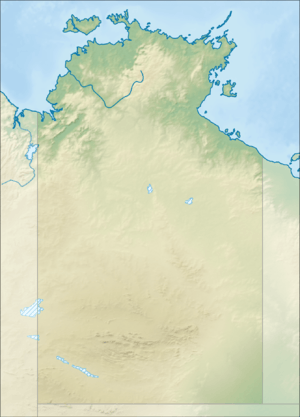Lake Amadeus
Lake Amadeus is a large salt lake in the southwest corner of Northern Territory of Australia, about 50 kilometres (31 mi) north of Uluru (also known as Ayers Rock). The smaller Lake Neale is adjacent to the northwest. It is part of (or a surface feature of) the Amadeus Basin that was filled with the erosion products of the Petermann Orogeny.
| Lake Amadeus | |
|---|---|
 From space (November 1994) | |
 Lake Amadeus | |
| Location | Petermann, Northern Territory[1] |
| Coordinates | 24°45′00″S 130°55′00″E[1] |
| Type | Salt lake |
| Basin countries | Australia |
| Max. length | 180 km (110 mi) |
| Max. width | 10 km (6.2 mi) |
| Surface area | 1,032 km2 (398 sq mi) |
Physical features
Due to the aridity of the area, the surface of Lake Amadeus is usually a dry salt crust. In times of sufficient rainfall, it is part of an east-flowing drainage system that eventually connects to the Finke River.
Lake Amadeus is 180 kilometres (110 mi) long and 10 kilometres (6.2 mi) wide, making it the largest salt lake in the Northern Territory.[2]
Lake Amadeus contains up to 600 million tonnes of salt; however, harvesting it has not proved viable, owing to its remote location.
History
Lake Amadeus is on Aboriginal land, and is covered by the Katiti and Petermann Aboriginal Land Trusts.[3]
The first European to arrive at the lake, the explorer Ernest Giles, encountered it in 1872. Giles originally intended to honour his benefactor Baron Ferdinand von Mueller with the eponym Lake Ferdinand. However, Mueller prevailed upon Giles to instead honour King Amadeo I of Spain (reigned 1870–1873, known in English as King Amadeus I), who had previously bestowed honour on him. The lake's expanse proved a barrier for Giles, who could see both the as yet undiscovered Ayers Rock and Kata Tjuta but could not reach them as the dry lake bed was not able to support the weight of his horses.[4] The next year, William Gosse climbed and named both rises.
See also
- List of lakes in Australia
- Post-abdication and legacy of Amadeo of Spain
- Tietkens expedition of 1889
References
- "Place Names Register Extract for "Lake Amadeus"". NT Place Names Register. Northern Territory Government. Retrieved 14 June 2019.
- "Largest Waterbodies". Geoscience Australia. Commonwealth of Australia. 23 December 2009. Retrieved 13 May 2010.
- "Lake Amadeus and Lake Neale" (PDF). Sites of conservation significance. Government of the Northern Territory, Department of Natural Resources, Environment, the Arts and Sport. p. 175. Archived from the original (PDF) on 7 March 2016. Retrieved 30 March 2013.
- Stanton, Jenny (2000). The Australian Geographic Book of the Red Centre. Terrey Hills, New South Wales: Australian Geographic. p. 44. ISBN 1-86276-013-6.